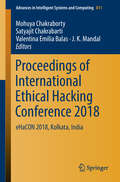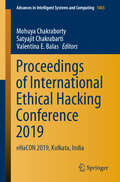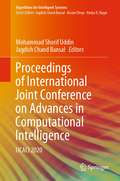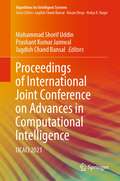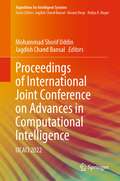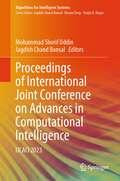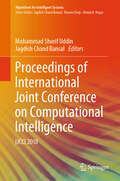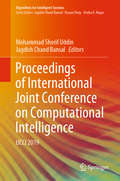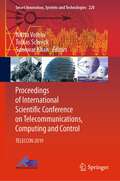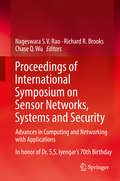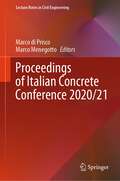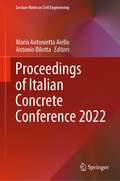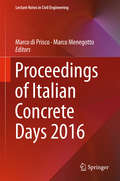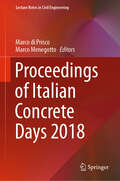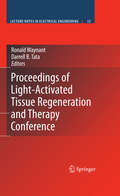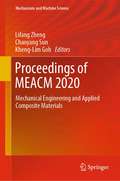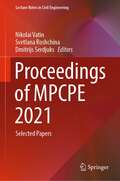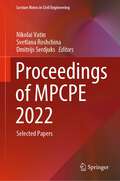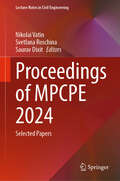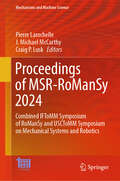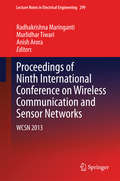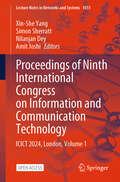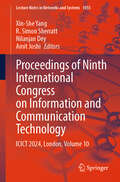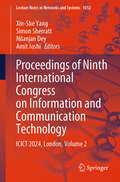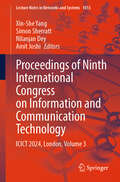- Table View
- List View
Proceedings of International Ethical Hacking Conference 2018: eHaCON 2018, Kolkata, India (Advances in Intelligent Systems and Computing #811)
by Valentina Emilia Balas J. K. Mandal Satyajit Chakrabarti Mohuya ChakrabortyThis book discusses the implications of new technologies for a secured society. As such, it reflects the main focus of the International Conference on Ethical Hacking, eHaCon 2018, which is essentially in evaluating the security of computer systems using penetration testing techniques. Showcasing the most outstanding research papers presented at the conference, the book shares new findings on computer network attacks and defenses, commercial security solutions, and hands-on, real-world security experience. The respective sections include network security, ethical hacking, cryptography, digital forensics, cloud security, information security, mobile communications security, and cyber security.
Proceedings of International Ethical Hacking Conference 2019: eHaCON 2019, Kolkata, India (Advances in Intelligent Systems and Computing #1065)
by Satyajit Chakrabarti Valentina E. Balas Mohuya ChakrabortyThis book gathers the peer-reviewed proceedings of the International Ethical Hacking Conference, eHaCON 2019, the second international conference of its kind, which was held in Kolkata, India, in August 2019. Bringing together the most outstanding research papers presented at the conference, the book shares new findings on computer network attacks and defenses, commercial security solutions, and hands-on, real-world security lessons learned. The respective sections include network security, ethical hacking, cryptography, digital forensics, cloud security, information security, mobile communications security, and cyber security.
Proceedings of International Joint Conference on Advances in Computational Intelligence: IJCACI 2020 (Algorithms for Intelligent Systems)
by Jagdish Chand Bansal Mohammad Shorif UddinThis book gathers outstanding research papers presented at the International Joint Conference on Advances in Computational Intelligence (IJCACI 2020), organized by Daffodil International University (DIU) and Jahangirnagar University (JU) in Bangladesh and South Asian University (SAU) in India. These proceedings present novel contributions in the areas of computational intelligence and offer valuable reference material for advanced research. The topics covered include collective intelligence, soft computing, optimization, cloud computing, machine learning, intelligent software, robotics, data science, data security, big data analytics, and signal and natural language processing.
Proceedings of International Joint Conference on Advances in Computational Intelligence: IJCACI 2021 (Algorithms for Intelligent Systems)
by Jagdish Chand Bansal Mohammad Shorif Uddin Prashant Kumar JamwalThis book gathers outstanding research papers presented at the 5th International Joint Conference on Advances in Computational Intelligence (IJCACI 2021), held online during October 23–24, 2021. IJCACI 2021 is jointly organized by Jahangirnagar University (JU), Bangladesh, and South Asian University (SAU), India. The book presents the novel contributions in areas of computational intelligence and it serves as a reference material for advance research. The topics covered are collective intelligence, soft computing, optimization, cloud computing, machine learning, intelligent software, robotics, data science, data security, big data analytics, and signal and natural language processing.
Proceedings of International Joint Conference on Advances in Computational Intelligence: IJCACI 2022 (Algorithms for Intelligent Systems)
by Jagdish Chand Bansal Mohammad Shorif UddinThis book gathers outstanding research papers presented at the 6th International Joint Conference on Advances in Computational Intelligence (IJCACI 2022), held in hybrid mode during October 15 – 16, 2022. IJCACI 2022 is jointly organized by Jahangirnagar University (JU), Bangladesh and South Asian University (SAU), India. The book presents the novel contributions in areas of computational intelligence and it serves as a reference material for advance research. The topics covered are collective intelligence, soft computing, optimization, cloud computing, machine learning, intelligent software, robotics, data science, data security, big data analytics, and signal and natural language processing.
Proceedings of International Joint Conference on Advances in Computational Intelligence: IJCACI 2023 (Algorithms for Intelligent Systems)
by Jagdish Chand Bansal Mohammad Shorif UddinThis book gathers outstanding research papers presented at the 7th International Joint Conference on Advances in Computational Intelligence (IJCACI 2023), held in hybrid mode at South Asian University, New Delhi, India during October 14–15, 2023. IJCACI 2023 is jointly organized by Jahangirnagar University (JU), Bangladesh and South Asian University (SAU), India. The book presents the novel contributions in areas of computational intelligence and it serves as a reference material for advance research. The topics covered are collective intelligence, soft computing, optimization, cloud computing, machine learning, intelligent software, robotics, data science, data security, big data analytics, and signal and natural language processing.
Proceedings of International Joint Conference on Computational Intelligence: IJCCI 2018 (Algorithms for Intelligent Systems)
by Jagdish Chand Bansal Mohammad Shorif UddinThis book gathers outstanding research papers presented at the International Joint Conference on Computational Intelligence (IJCCI 2018), which was held at Daffodil International University on 14–15 December 2018. The topics covered include: collective intelligence, soft computing, optimization, cloud computing, machine learning, intelligent software, robotics, data science, data security, big data analytics, and signal and natural language processing.
Proceedings of International Joint Conference on Computational Intelligence: IJCCI 2019 (Algorithms for Intelligent Systems)
by Jagdish Chand Bansal Mohammad Shorif UddinThis book gathers outstanding research papers presented at the International Joint Conference on Computational Intelligence (IJCCI 2019), held at the University of Liberal Arts Bangladesh (ULAB), Dhaka, on 25–26 October 2019 and jointly organized by the University of Liberal Arts Bangladesh (ULAB), Bangladesh; Jahangirnagar University (JU), Bangladesh; and South Asian University (SAU), India. These proceedings present novel contributions in the areas of computational intelligence, and offer valuable reference material for advanced research. The topics covered include collective intelligence, soft computing, optimization, cloud computing, machine learning, intelligent software, robotics, data science, data security, big data analytics, and signal and natural language processing.
Proceedings of International Scientific Conference on Telecommunications, Computing and Control: TELECCON 2019 (Smart Innovation, Systems and Technologies #220)
by Nikita Voinov Tobias Schreck Sanowar KhanThis book provides a platform for academics and practitioners for sharing innovative results, approaches, developments, and research projects in computer science and information technology, focusing on the latest challenges in advanced computing and solutions introducing mathematical and engineering approaches. The book presents discussions in the area of advances and challenges of modern computer science, including telecommunications and signal processing, machine learning and artificial intelligence, intelligent control systems, modeling and simulation, data science and big data, data visualization and graphics systems, distributed, cloud and high-performance computing, and software engineering. The papers included are presented at TELECCON 2019 organized by Peter the Great St. Petersburg University during November 18–19, 2019.
Proceedings of International Symposium on Sensor Networks, Systems and Security: Advances In Computing And Networking With Applications
by Nageswara S. V. Rao Richard R. Brooks Chase Q. WuThis book presents current trends that are dominating technology and society, including privacy, high performance computing in the cloud, networking and IoT, and bioinformatics. By providing chapters detailing accessible descriptions of the research frontiers in each of these domains, the reader is provided with a unique understanding of what is currently feasible. Readers are also given a vision of what these technologies can be expected to produce in the near future. The topics are covered comprehensively by experts in respective areas. Each section includes an overview that puts the research topics in perspective and integrates the sections into an overview of how technology is evolving. The book represents the proceedings of the International Symposium on Sensor Networks, Systems and Security, August 31 – September 2, 2017, Lakeland Florida.
Proceedings of Italian Concrete Conference 2020/21 (Lecture Notes in Civil Engineering #351)
by Marco Di Prisco Marco MenegottoThis book gathers the peer-reviewed papers presented at the Italian Concrete Conference 2020, held on April 14-17, 2021. The conference topics encompass the aspects of design, execution, rehabilitation and control of concrete structures, with particular reference to theory and modeling, applications and realizations, materials and investigations, technology and construction techniques. The contributions amply demonstrate that today’s structural concrete applications concern not only new constructions, but more and more rehabilitation, conservation, strengthening and seismic upgrading of existing buildings, and that requirements cover new aspects within the frame of sustainability, including environmental friendliness, durability, adaptability and reuse of works and / or materials. As such, the book represents an invaluable, up-to-the-minute tool, providing an essential overview of structural concrete, as well as all of new materials with cementitious matrices.
Proceedings of Italian Concrete Conference 2022 (Lecture Notes in Civil Engineering #435)
by Maria Antonietta Aiello Antonio BilottaThis book gathers the best peer-reviewed papers presented at the Italian Concrete Conference, held in Naples, Italy, on October 12-15, 2022. The conference topics encompass the aspects of design, execution, rehabilitation, and control of concrete structures, with particular reference to theory and modeling, applications and realizations, materials and investigations, technology, and construction techniques. The contributions amply demonstrate that today’s structural concrete applications concern not only new constructions, but more and more rehabilitation, conservation, strengthening, and seismic upgrading of existing premises, and that requirements cover new aspects within the frame of sustainability, including environmental friendliness, durability, adaptability, and reuse of works and/or materials. As such, the book represents an invaluable, up-to-the-minute tool, providing an essential overview of structural concrete, as well as all new materials with cementitious matrices.
Proceedings of Italian Concrete Days 2016 (Lecture Notes in Civil Engineering #10)
by Marco Di Prisco Marco MenegottoThis book gathers the best peer-reviewed papers presented at the Italian Concrete Days national conference, held in Rome, Italy, on October 27-28, 2016. The conference topics encompass the aspects of design, execution, rehabilitation and control of concrete structures, with particular reference to theory and modeling, applications and realizations, materials and investigations, technology and construction techniques. The contributions amply demonstrate that today’s structural concrete applications concern not only new constructions, but more and more rehabilitation, conservation, strengthening and seismic upgrading of existing premises, and that requirements cover new aspects within the frame of sustainability, including environmental friendliness, durability, adaptability and reuse of works and / or materials. As such the book represents an invaluable, up-to-the-minute tool, providing an essential overview of structural concrete, as well as all new materials with cementitious matrices.
Proceedings of Italian Concrete Days 2018 (Lecture Notes in Civil Engineering #42)
by Marco Di Prisco Marco MenegottoThis book gathers the best peer-reviewed papers presented at the Italian Concrete Days national conference, held in Lecco, Italy, on June 14-15, 2018. The conference topics encompass the aspects of design, execution, rehabilitation and control of concrete structures, with particular reference to theory and modeling, applications and realizations, materials and investigations, technology and construction techniques. The contributions amply demonstrate that today’s structural concrete applications concern not only new constructions, but more and more rehabilitation, conservation, strengthening and seismic upgrading of existing premises, and that requirements cover new aspects within the frame of sustainability, including environmental friendliness, durability, adaptability and reuse of works and / or materials. As such the book represents an invaluable, up-to-the-minute tool, providing an essential overview of structural concrete, as well as all new materials with cementitious matrices.
Proceedings of Light-Activated Tissue Regeneration and Therapy Conference
by Ronald Waynant Darrell B. TataThis book is the first to present the mechanism which explains why light is an effective treatment for so many illnesses and diseases. The book not only explains this mechanism, but describes uses for the mechanism, as well as what new work is planned and what changes will be seen in FDA regulations. Extensive papers and coverage on many interesting topics are included.
Proceedings of MEACM 2020: Mechanical Engineering and Applied Composite Materials (Mechanisms and Machine Science #99)
by Lifang Zheng Chaoyang Sun Kheng-Lim GohThis book gathers the proceedings of the 4th International Conference on Mechanical Engineering and Applied Composite Materials (MEACM), held in Beijing, China on October 24-25, 2020. The conference brought together researchers from several countries and covered all major areas of mechanical engineering and applied composite materials, new applications and current trends. The topics covered include: structure and design, mechanical manufacturing and automation, robotics and mechatronics, mechanical behavior of nanomaterials, nanocomposites, and composite mechanics. Given its scope, the book offers a source of information and inspiration for researchers seeking to improve their work and gather new ideas for future developments.
Proceedings of MPCPE 2021: Selected Papers (Lecture Notes in Civil Engineering #182)
by Nikolai Vatin Svetlana Roshchina Dmitrijs SerdjuksThis book gathers selected contributions in the field of civil and structural engineering, as presented by international researchers and engineers at the International Conference on Materials Physics, Building Structures and Technologies in Construction, Industrial and Production Engineering (MPCPE), held in Vladimir, Russia on April 26-28 2021. The book covers a wide range of topics including the theory and design of capital construction facilities, engineering and hydraulic structures; development of innovative solutions in the field of modeling and testing of reinforced concrete, metal and wooden structures, as well as composite structures based on them; investigation of complex dynamic effects on construction objects, and many others directions. Intended for professional builders, designers and researchers. The contributions, which were selected by means of a rigorous international peer-review process, highlight numerous exciting ideas that will spur novel research directions and foster multidisciplinary collaborations.
Proceedings of MPCPE 2022: Selected Papers (Lecture Notes in Civil Engineering #335)
by Nikolai Vatin Svetlana Roshchina Dmitrijs SerdjuksThis book gathers selected contributions in the field of civil and structural engineering, as presented by international researchers and engineers at the International Conference on Materials Physics, Building Structures and Technologies in Construction, Industrial and Production Engineering (MPCPE), held in Vladimir, Russia, on April 26–28, 2022. The book covers a wide range of topics including the theory and design of capital construction facilities, engineering, and hydraulic structures; development of innovative solutions in the field of modeling and testing of reinforced concrete, metal, and wooden structures, as well as composite structures based on them; investigation of complex dynamic effects on construction objects, and many others directions. Intended for professional builders, designers, and researchers. The contributions, which were selected by means of a rigorous international peer-review process, highlight numerous exciting ideas that will spur novel research directions and foster multidisciplinary collaborations.
Proceedings of MPCPE 2024: Selected Papers (Lecture Notes in Civil Engineering #576)
by Nikolai Vatin Svetlana Roschina Saurav DixitThis book gathers selected contributions in the field of civil and structural engineering, as presented by international researchers and engineers at the International Conference on Materials Physics, Building Structures and Technologies in Construction, Industrial and Production Engineering (MPCPE), held in Vladimir, Russia, on April 22–25, 2024. The book covers a wide range of topics including the theory and design of capital construction facilities, engineering, and hydraulic structures; development of innovative solutions in the field of modeling and testing of reinforced concrete, metal, and wooden structures, as well as composite structures based on them; investigation of complex dynamic effects on construction objects, and many others directions. Intended for professional builders, designers, and researchers. The contributions, which were selected by means of a rigorous international peer-review process, highlight numerous exciting ideas that will spur novel research directions and foster multidisciplinary collaborations.
Proceedings of MSR-RoManSy 2024: Combined IFToMM Symposium of RoManSy and USCToMM Symposium on Mechanical Systems and Robotics (Mechanisms and Machine Science #159)
by Pierre Larochelle J. Michael McCarthy Craig P. LuskThis book gathers the latest fundamental research contributions, innovations, and applications in the field of design and analysis of complex robotic mechanical systems, machines, and mechanisms, as presented by leading researchers at the combined IFToMM Symposium of RoManSy and USCToMM Symposium on Mechanical Systems and Robotics (MSR-RoManSy), held in St. Petersburg, FL, USA, on May 22–25, 2024. It covers highly diverse topics, including soft, wearable, and origami robotic systems; applications to walking, flying, climbing, underground, swimming, and space systems; human rehabilitation and performance augmentation; design and analysis of mechanisms and machines; human–robot collaborative systems; service robotics; mechanical systems and robotics education; and the commercialization of mechanical systems and robotics. The contributions, which were selected by means of a rigorous international peer-review process, highlight numerous exciting and impactful research results that will inspire novel research directions and foster multidisciplinary research collaborations among researchers from around the globe.
Proceedings of Ninth International Conference on Wireless Communication and Sensor Networks
by Radhakrishna Maringanti Murlidhar Tiwari Anish AroraWireless communication and sensor networks would form the backbone to create pervasive and ubiquitous environments that would have profound influence on the society and thus are important to the society. The wireless communication technologies and wireless sensor networks would encompass a wide range of domains such as HW devices such as motes, sensors and associated instrumentation, actuators, transmitters, receivers, antennas, etc. , sensor network aspects such as topologies, routing algorithms, integration of heterogeneous network elements and topologies, designing RF devices and systems for energy efficiency and reliability etc. These sensor networks would provide opportunity to continuously and in a distributed manner monitor the environment and generate the necessary warnings and actions. However most of the developments have been demonstrated only in controlled and laboratory environments. So we are yet to see those powerful, ubiquitous applications for the benefit of the society. The conference and consequentially the proceedings would provide opportunity to the researchers to interact with other researchers and share their researches covering all the above areas. The proceedings of the conference thus covers the research work of different authors in the area of wireless sensor networks, wireless communications, devices, tools and techniques for WSN, and applications of wireless sensor networks. This book is beneficial for those researchers who are working in the area of wireless sensor networks, wireless communication, and developing applications of Wireless sensor networks.
Proceedings of Ninth International Congress on Information and Communication Technology: ICICT 2024, London, Volume 1 (Lecture Notes in Networks and Systems #1011)
by Xin-She Yang Nilanjan Dey Amit Joshi Simon SherrattThis open access book gathers selected high-quality research papers presented at the Ninth International Congress on Information and Communication Technology, held at Brunel University, London, on February 19–22, 2024. It discusses emerging topics pertaining to information and communication technology (ICT) for managerial applications, e-governance, e-agriculture, e-education and computing technologies, the Internet of Things (IoT), and e-mining. Written by respected experts and researchers working on ICT, the book offers an asset for young researchers involved in advanced studies. The work is presented in ten volumes.
Proceedings of Ninth International Congress on Information and Communication Technology: ICICT 2024, London, Volume 10 (Lecture Notes in Networks and Systems #1055)
by Xin-She Yang Nilanjan Dey Amit Joshi R. Simon SherrattThis book gathers selected high-quality research papers presented at the Ninth International Congress on Information and Communication Technology, held in London, on February 19–22, 2024. It discusses emerging topics pertaining to information and communication technology (ICT) for managerial applications, e-governance, e-agriculture, e-education and computing technologies, the Internet of Things (IoT), and e-mining. Written by respected experts and researchers working on ICT, the book offers an asset for young researchers involved in advanced studies. The work is presented in ten volumes.
Proceedings of Ninth International Congress on Information and Communication Technology: ICICT 2024, London, Volume 2 (Lecture Notes in Networks and Systems #1012)
by Xin-She Yang Nilanjan Dey Amit Joshi Simon SherrattThis book gathers selected high-quality research papers presented at the Ninth International Congress on Information and Communication Technology, held at Brunel University, London, on February 19–22, 2024. It discusses emerging topics pertaining to information and communication technology (ICT) for managerial applications, e-governance, e-agriculture, e-education and computing technologies, the Internet of Things (IoT), and e-mining. Written by respected experts and researchers working on ICT, the book offers an asset for young researchers involved in advanced studies. The work is presented in ten volumes.
Proceedings of Ninth International Congress on Information and Communication Technology: ICICT 2024, London, Volume 3 (Lecture Notes in Networks and Systems #1013)
by Xin-She Yang Nilanjan Dey Amit Joshi Simon SherrattThis book gathers selected high-quality research papers presented at the Ninth International Congress on Information and Communication Technology, held at Brunel University, London, on February 19–22, 2024. It discusses emerging topics pertaining to information and communication technology (ICT) for managerial applications, e-governance, e-agriculture, e-education and computing technologies, the Internet of Things (IoT), and e-mining. Written by respected experts and researchers working on ICT, the book offers an asset for young researchers involved in advanced studies. The work is presented in ten volumes.
